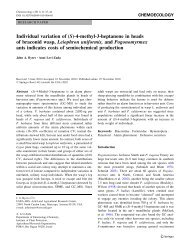EFFECTIVE ATTRACTION RADIUS: A Method ... - Chemical Ecology
EFFECTIVE ATTRACTION RADIUS: A Method ... - Chemical Ecology
EFFECTIVE ATTRACTION RADIUS: A Method ... - Chemical Ecology
You also want an ePaper? Increase the reach of your titles
YUMPU automatically turns print PDFs into web optimized ePapers that Google loves.
758 BYERS ET AL.<br />
I---<br />
"t-<br />
O<br />
(J<br />
400<br />
300<br />
tO<br />
u.1<br />
_J<br />
I--<br />
I.LI<br />
U.I<br />
200<br />
100<br />
0 I I I I I 1<br />
0 10 20 30 40 50 60<br />
TRAP RAD I US (cm)<br />
FIG. 4. Logarithmic relationship between number of I. typographus caught on pheromone<br />
baits and increasing radius of the sticky-screen trap at 1.5-m height. Traps released<br />
5 mg/day of 2-methyl-3-butene-2-ol and 0.1 mg/day of cis-verbenol. The encircled point<br />
shows the size of trap used in the attractive and passive pole experiments.<br />
a few levels, (3) traps at widely spaced levels (up to 150 m height), or (4) traps<br />
that collected beetles for several months. Our 10 passive traps from 0.7 to 11.5<br />
m high appeared sufficient to determine with some precision the distribution of<br />
flight heights over the normal flight range for H. palliatus, Cryphalus abietis<br />
Ratz., T. domesticum, P. bidentatus, P. quadridens, and L typographus but<br />
not, apparently, for P. chalcographus and T. piniperda (Figures 1 and 2). The<br />
catch for T. piniperda was too low to reliably estimate the distribution. On the<br />
other hand, P. chaIcographus exhibited a uniform distribution, except at the<br />
bottom level, which probably indicates they were flying also at higher levels<br />
than the range of traps, as if they were dispersing through the pine forest (a<br />
nonhost tree).<br />
In one of the first studies of flight-height distribution in bark beetles, Gara<br />
and Vit6 (1962) used rotary net traps to suggest that no differences in flight<br />
activity of Dendroctonus brevicomis LeConte and other bark beetles occurred<br />
from ground level to lower crown regions, but "in the upper crown and above<br />
forest stands, bark beetles seemed to fly less frequently." Shore and McLean<br />
(1984) found Trypodendron lineatum O1. responded over 76 days to lineatinbaited<br />
traps at 0-, 1-, 2-, 3-, and 4-m heights with most (31.6%) caught on the<br />
1-m trap at the level just above the underbrush (effectively the lowest trap). The





